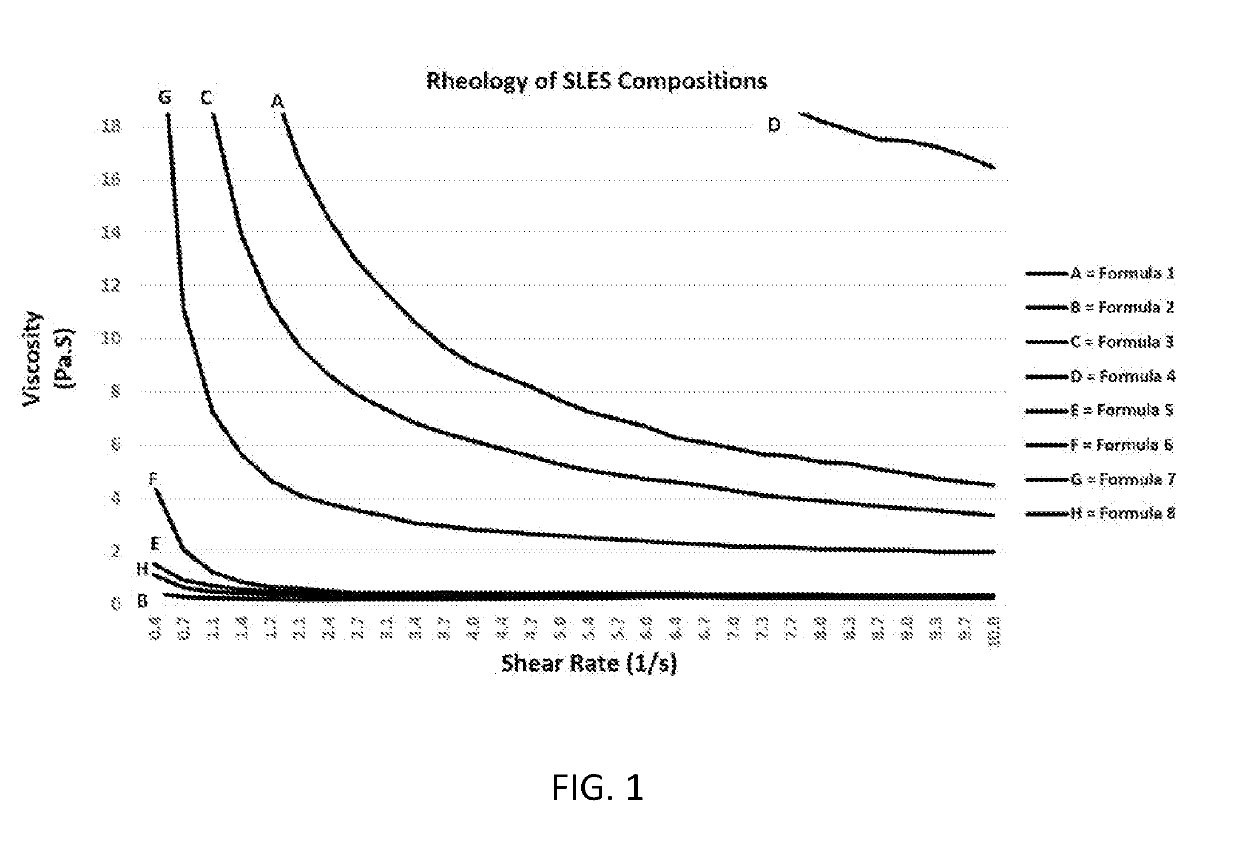Use of an alcohol hybrid to modify the rheology of polyethoxylated alcohol sulfates
a polyethoxylated alcohol and hybrid technology, applied in the preparation of detergent mixture compositions, detergent compounding agents, organic chemistry, etc., can solve the problems of sles/ethanol blends a potential fire hazard, difficult to use (i.e., 100%) sles, and difficult to handle sles
- Summary
- Abstract
- Description
- Claims
- Application Information
AI Technical Summary
Benefits of technology
Problems solved by technology
Method used
Image
Examples
example 1
[0111]Preparation of SLES Compositions
[0112]In order to compare differences in rheology of SLES as a result of the addition of ethanol and / or at least one of other alcohols, SLES compositions of eight formulas were prepared: Formula 1 includes 70 parts SLES and 30 parts water only; Formula 2 includes 60 parts a mixture of SLES and water (SLES:water=7:3), 12 parts ethanol, and no a polyol; Formula 3 includes 60 parts SLES and water mixture (SLES:water=7:3), 6 parts ethanol, and no polyol; Formula 4 includes 60 parts SLES and water mixture (SLES:water=7:3), no ethanol, and 12 parts PEG 400; Formula 5 includes 60 parts SLES and water mixture (SLES:water=7:3), 6 parts ethanol, and 12 parts PEG 400; Formula 6 includes 60 parts SLES and water mixture (SLES:water=7:3), 6 parts ethanol, and 12 parts propylene glycol (PG); Formula 7 includes 60 parts SLES and water mixture (SLES:H2O=7:3), 6 parts ethanol, and 12 parts glycerine (Gly); and Formula 8 includes 60 parts SLES and water mixture (S...
example 2
[0114]Rheology Measurement of the SLES Compositions
[0115]Rheology measurements were conducted using an AR2000-EX Rheometer with a test method of increasing the shear rate from 0.41 to 10 l / s over 5 minutes at 20° C. with a geometry cone of 40 mm, 1:59:49 (degree:min:sec), and a truncation gap of 52 microns (cone is part number 511406.901). Viscosities (Pa·S) of the SLES Blend Formulations prepared in Example 1 were measured and reported in Table 1. “SLES*” in the Table of the application stands for a mixture of SLES and water with a ratio of 7:3.
TABLE 1Formula234581SLES*:Etha-SLES*:Etha-SLES*:Etha-SLES*:Etha-67SLES*:Etha-SLES*nol:(PG / Gly / nol:(PG / Gly / nol:PEGnol:PEGSLES*:Etha-SLES*:Etha-nol:PEGShearonly, noPEG) =PEG) =400 =400 =nol:PG =nol:Gly =400 =Ratealcohol(s)60:12:060:6:060:0:1260:6:1260:6:1260:6:1260:6:18(1 / s)Viscosity (Pa · S)0.4195.5100.42955.070121.8001.5114.48725.1001.0860.7549.4800.29428.73071.8600.9162.05911.1400.6461.0832.9800.23218.62053.3200.6961.2097.2570.4821.4124.730...
example 3
[0124]Preparation of Laundry Detergent Compositions Comprising SLES
[0125]Laundry detergent compositions using the SLES blend, as set forth in Table 2, were prepared by following conventional methods of preparation. Instead of using highly viscous SLES, a flowable and processable SLES blend was used during the manufacturing process.
Composition 1Composition 2Composition 3Description(% wt)(% wt)(% wt)C12-C15 Alcohol 23.123.123.1Ethoxylate 7EOPEG 40018.500SLES Blend 18.7200(60 parts SLESpremix, 12 parts ethanol)SLES Blend 020.260(60 parts SLESpremix, 6 parts ethanol, 12 parts PEG 400)SLES Blend 0021.85(60 parts SLESpremix, 6 parts ethanol, 18 parts PEG 400)Glycerine999Propylene Glycol777Bases1.51.51.5Fatty Acid444Enzymes1.51.51.5Other Ingredients1.11.11.1Water13.61210.5Polymeric 222DispersantTotal100100100
[0126]As shown in Compositions 2 and 3, one advantage of using the SLES blend having PEG 400 as a co-diluent is that, depending on the amount of PEG 400 needed in a detergent compositi...
PUM
| Property | Measurement | Unit |
|---|---|---|
| weight | aaaaa | aaaaa |
| weight ratio | aaaaa | aaaaa |
| detergent | aaaaa | aaaaa |
Abstract
Description
Claims
Application Information
 Login to View More
Login to View More - R&D
- Intellectual Property
- Life Sciences
- Materials
- Tech Scout
- Unparalleled Data Quality
- Higher Quality Content
- 60% Fewer Hallucinations
Browse by: Latest US Patents, China's latest patents, Technical Efficacy Thesaurus, Application Domain, Technology Topic, Popular Technical Reports.
© 2025 PatSnap. All rights reserved.Legal|Privacy policy|Modern Slavery Act Transparency Statement|Sitemap|About US| Contact US: help@patsnap.com

